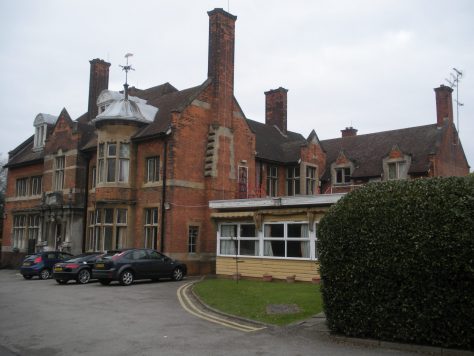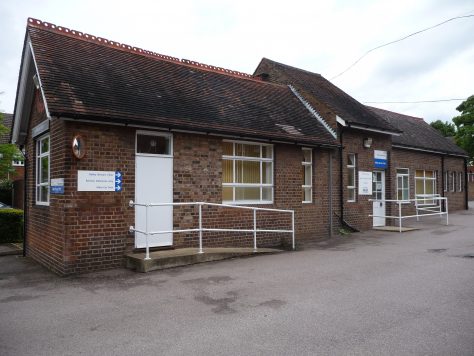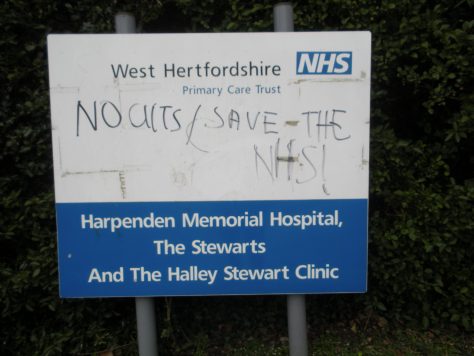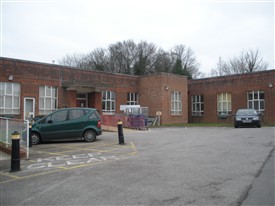The Red House in Carlton Road was rebuilt in 1896 by Alfred Vaughan Stevens after the disastrous fire which destroyed the family home he had built in 1892. It was bought in 1904 by Sir Halley Stewart, (1838-1937), vice-chairman of the London Brick Company and a great philanthropist, whose benefactions included giving, in 1934, £5000 to the campaign to save Rothamsted from the developers.

South front of rebuilt Red House. Credit: Rosemary Ross, March 2011
In 1920 a Nursing Centre was established at 40 Luton Road (now redeveloped as St Helena’s Court), as a memorial to the men of Harpenden who fell in the 1914-18 war. Ten years later, in 1930, Sir Halley Stewart offered to give the Red House to the town for use as a hospital. Following his death in 1937, instead of converting the house itself a purpose-built annexe was erected, completed in 1940 and opened to patients in 1941. The cost of conversion was some £18,000, largely contributed by the people of Harpenden.

Red House, with day-room annex. Credit: Rosemary Ross, March 2011

“The Stewarts”. Credit: Rosemary Ross, March 2011

Halley Stewart Clinic. Credit: Gavin Ross, June 2011
Inauguration of the NHS
In 1948 the hospital was absorbed into the National Health Service and allocated to the Luton and Hitchin Management Committee, which naturally led to a linkage with the Luton and Dunstable Hospital. The reorganisation of 1974 saw its transfer to the NW district of Hertfordshire Area Health Authority. This led in 1976 to a proposal to close the hospital, leading to a public outcry and campaign to keep it open, led by the League of Friends of Harpenden Memorial Hospital, and supported by the new NW Herts Community Health Council. The decision to keep the hospital open was partly influenced by legal arguments relating to its former charitable status.
In 1976 there were 32 beds, including 10 maternity beds, an operating theatre, an outpatient department and a physiotherapy department. The care of in-patients and casualty cases was undertaken by local GPs, there being no resident medical staff. It was a Community Hospital, offering minor to medium surgical operations such as hernia treatment, varicose veins and removal of tonsils. A wide range of treatments falling within the scope of the general practitioner was given in the wards. Consultants regularly attended the outpatient department, and the casualty department was a nurse-led unit treating minor injuries. The maternity unit delivered about 250 live births per year under the supervision of local GPs. Mothers-to-be were screened for suitability for such deliveries as were not expected to involve complications.
Closure of Maternity Unit
The next crisis date was 1984, when the NW Herts Health Authority announced plans to close the maternity unit, following an adverse national report on the safety of isolated maternity units. It was argued that GPs would be allowed to deliver births at a new maternity unit at St Albans City Hospital, where consultants would be on hand in the case of complications. The closure went through in 1985, despite protest campaigns, but the promised alternative at St Albans never materialised.
The 1984 plans did however provide for increased use of the site, with a day surgery unit, and a new separate mental health centre for the elderly, to be built on the site of the disused mortuary building. This was finally opened in 1995, known as ‘The Stewarts’. Meanwhile part of the land was sold off to allow The Elms Practice to open a purpose-built surgery in Stewart Road.
More changes, more plans …
Further NHS reorganisations in 1992-3 placed the hospital under the Dacorum and St Albans Community NHS Trust. Plans to increase the number of beds from 24 to 48 were announced, but the money was never found. ‘The Stewarts’ was managed separately by Hertfordshire Partnership Trust.
In 2006 the Herts Primary Care Trust decided to close the elderly care beds and transfer all patients to St Albans City Hospital. There was a further campaign by the League of Friends, now called the Friends of Harpenden Memorial Hospital, and this was supported by Harpenden Town Council. But the closures went ahead, and the in-patients wards were left empty, with the promise that if the local GPs could find a use for them, together with the necessary capital funding to improve them, then they could be re-opened. But in 2011 they remain closed. Outpatient services, including blood tests, continue as before, but the long-term outlook is unclear.

Feelings still run high – graffiti, March 2011. Credit: Rosemary Ross, March 2011
References:
David Newton (1968), Sir Halley Stewart. Geo. Allen and Unwin
League of Friends (1976), The Harpenden Memorial Hospital, Its past, present and future.


Comments about this page
I was born on 27 August 1948 at the Redhouse and delivered by Dr Hester
I was born in the Red House in 1948. My mother is now 96 and talks very fondly of her time there and the excellent care she received.
We have lived in South Africa since 1963. I once visited just to sit and look at this lovely and historic building.
I was born in the Red House in 1980! I now live in Canada but I have been back and stopped twice – my Mum told me what a lovely experience it was delivering there with the help of a midwife.
I was born in the Red House in 1945, l also had my son there in 1964. Sister West delivered me, & was still working there & delivered my son. It was a lovely little village hospital. I now live in Canada & have for 53 yrs.
I was born in the Red House in 1956. My husband was born 8 days after me in the same hospital. There couldn’t of been many babies born there then as our birth certificate numbers follow on. We never knew each other until 1975!
I was born in the Red House in 1948. It was winter. My mother walked from Oakley Road to the Red House (about a mile and a half) when her labour had started. As soon as she arrived she was given an enema. She never let me forget that!!! My sister was born there two years and eight months later. Mum was scared of the possibility of another enema.
I was born in the Red House in November 1943. It was interesting to learn about the history of the place, and a bit disappointing to hear that the Maternity Home has long since gone. My thanks to those who have created this site.
Fond memories of The Red House from the 1960s to 1980s. My mother- in-law Betty Bland, now deceased, used to do the trolley run with teas and coffee until she was 90. My late father-in-law Jack Bland used to work as a porter at the hospital. I used to make a point, when on night duty, of visiting the Red House for a cup of tea and a warm up, and of course to check all was OK. A policeman’s lot was not a happy one so I have heard.
Not too soon I hope!
I am a 5th generation Australian (Tasmanian), but was born at The Red House in 1950 when my parents were living in Harpenden. My father worked at Rothamsted as a research scientist.
My Mother had me and my three brothers at the Red House Hospital. Soon there will be no person born in Harpenden.
I worked there as a maid before I started my nurses training at the L&D. I lived upstairs in one of the rooms overlooking the front of the house. I was there from 1973 – 1974. It was a great experience, the house was so old and had so much character. Miss Julia Blanche was the Matron and she was so nice, she had trained as a nurse in London during the war. Mr. Gray and Mr. Cox were the orderlies and they also assisted with delivering the patients to surgery. They were both characters. Mrs Chance was the cook, she used to have tearful episodes when she would talk about her husband who had gone missing in action during the war. Mrs Chance was such a good cook and everything was made from scratch – not like today. I had to assist her in the kitchen on occasion, and in the summer she would send me out into the garden to pick the vegetables. Mr. Miller was the gardener and he spoke with a very distinct “Thomas Hardy” area of Britain accent. This man could grow anything. I really feel privileged to have experienced living at The Red House, and it is something that is from a by gone era but I have so many nice memories of the place and the people I worked with. I worked with such excellent nurses who gave me a firm basis of patient care so that when I became a student I had a good foundation.
I visited the House in 1999 and was so upset to see that Mr. Miller’s beautiful garden had been turned into a car park. He poured so much love into that garden and it was really sad for me to see that it was gone. Progress isn’t always progress.
I now reside in the United States and work as a nurse and when I tell my co-workers about my experiences while at the Red House they ask me if I am sure this was in the twentieth century and not the nineteenth and they laugh….. !
I worked as a student nurse in the Red House, in the 1960s. Was a great place to work. Really sad that the Red House is not a working hospital now like it was.
I refer to the threat to The Red House and wonder if there is any mileage in pursuing the possibility of having the property Listed. I notice that according to the short history the building was rebuilt in 1896, perhaps there are structures/parts which pre-date that. This might meet some English Heritage requirements.
Ed. The first Red House was built in 1892 and burnt down due to an electrical fault. It seems likely that parts of the older building – walls, window frames – were incorporated in the rebuilding.
Add a comment about this page